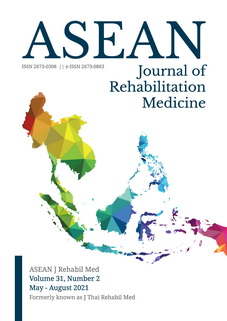Effects of the Self-Ischemic Compression by a T-shaped Wood Stick in Participants with Upper Trapezius Myofascial Trigger Point: A Randomized Controlled Trial
คำสำคัญ:
self-ischemic compression, myofascial pain syndrome, pain, trigger point, stretching exerciseบทคัดย่อ
Objectives: To determine the effectiveness of the self-ischemic compression by using a T-shaped wood stick and followed by sustained stretching on pain and quality of life in participants with upper trapezius myofascial trigger point (MTrP).
Study design: Single blinded randomized controlled trial.
Setting: Outpatient rehabilitation clinic at Siriraj Hospital, Thailand.
Subjects: Forty-eight participants (9 males, 39 females), aged 18-55 years old, with moderate pain of unilateral or bilateral upper trapezius myofascial pain syndrome.
Methods: The participants were randomized into two groups. The intervention group received the T-shaped wood stick to perform self-ischemic compression on MTrP followed by sustained stretching, whereas the controlled group was instructed to do sustained stretching. Both groups were asked to perform according to the instruction twice a day for 5 days. The outcomes were assessed before treatment and followed-up on day 8. A visual analog scale as the primary outcome, and pain pressure threshold were used to assess pain intensity. Active cervical lateral flexion range of motion, and the Thai-version of neck disability index was used to measure the quality of life.
Results: There was statistically significant improvement of visual analog scale between groups but no statistically changes in pain pressure threshold and the Thai-version of neck disability index were observed.
Conclusion: Self-ischemic compression with a T-shaped wood stick followed by sustained stretching showed short-term improvement of pain intensity in chronic upper trapezius myofascial pain syndrome with moderate pain.
Keywords: self-ischemic compression, myofascial pain syndrome, pain, trigger point, stretching exercise
เอกสารอ้างอิง
Pongsatornkulpanit A, Chaiamniau P, Asavabadi P, Kongkiatngam A. Myofascial pain syndrome in Thai community. J Thai Rheumatol.1995;4:2-9.
Bal S, Çeliker R. Health-related quality of life in patients withmyofascial syndrome: a controlled clinical study. J Musculoskel Pain. 2009;17:173-17.
Reyhan Ç, Ayçe A. Health-related quality of life in patients with myofascial pain syndrome. Curr Pain Headache Rep. 2010;14:361-6.
Somnuk T. Mental health of patients with myofascial pain syndrome. J Thai Rehabil Med. 2011;21:1-6.
Hoy DG, Protani M, De R, Buchbinder R. The epidemiology of neck pain. Best Pract Res Clin Rheumatol. 2010;24:783-92.
Simons DG, Travel JG, Simons LS. Travell & Simons’ myofascial pain and dysfunction: the trigger point manual. Vol.1. Upper half of body. 2nd ed. Baltimore: Williams & Winkins; 1998. p. 94-177.
Prateepavanich P. Myofascial pain syndrome, Bangkok: Amarin Printing & Publishing Public; 2016. p. 10-18.
Mense S, Masi A. Increased muscle tone as a cause of muscle pain: understanding the mechanisms. Heidelberg: Springer; 2011. p. 207-49.
Treaster D, Marras W. Myofascial trigger point development from visual and postural stressors during computer work. J Electromyogr Kinesiol. 2006;16:115-24.
Pragnya R, Karthika H, Antony P. Effectiveness of ischemic compression on trapezius myofascial trigger points in neck pain. Int J Physiother. 2016;3:186-92.
Menakam P, Kalaichandran M. Effect of ischemic compression followed by stretching on myofascial trigger points. Int J Sci Res. 2015;5:1-6.
Moraska AF, Hickner RC, Kohrt WM, Brewer A. Changes in blood flow and cellular metabolism at a myofascial trigger point with trigger point release (ischemic compression): a proof of principle pilot study. Arch Phys Med Rehabil. 2013;94:196-200.
Hanten, William P, Olson, Sharon L. Effectiveness of a home program of ischemic compression followed by sustained stretch for treatment of myofascial trigger point. Phys Ther. 2000;80:997-1003.
Boonstra M, Preuper H, Reneman M, Posthumus J, Stewart R. Reliability and validity of the visual analogue scale for disability in patients with chronic musculoskeletal pain. Int J Rehabil Res. 2008;31:165-9.
Dauphin AP, Guillemin F, Virion J, Briançon F. Bias and precision in visual analogue scales: a randomized controlled trial. Am J Epidemiol.1999;150:1117-27.
Fischer A. Pressure threshold meter: its use for quantification of tender spots. Arch Phys Med Rehabil. 1986;67:836-8.
David W, Macdermid J, Nielson W, Teasell R, Chiasson M, Brown L. Reliability, standard error, and minimum detectable change of clinical pressure pain threshold testing in people with and without acute neck pain. J Orthop Sports Phys Ther. 2011;41:644-50.
Park G, Kim C, Park S, Kim M, Jang S. Reliability and usefulness of the pressure pain threshold measurement in patients with myofascial pain. Ann Rehabil Med 2011;35:412-7.
Luksanapruksa P, Watjama-apisit T, Wanasinthop S, Sanpakit S, Chavasiri C. Reliability and validity study of a Thai version of the neck dyability index in patients with neck pain. J Med Assoc Thai. 2012;95:681-8.
Pool J, Ostelo R, Hoving J, Bouter L, Vet H. Minimal clinically important change of the neck disability index and the numerical rating scale for patients with neck pain. Spine. 2007;32:3047-51.
Mark P, Jensen, Connie Chen. Interpretation of visual analog scale ratings and change scores: are analysis of two clinical trials of postoperative pain. J Pain. 2003;4:407-14.
Hou C, Tsai L, Cheng K, Chung K, Hong C. Immediate effects of various physical therapeutic modalities on cervical myofascial pain and trigger point sensitivity. Arch Phys Med Rehabil. 2002;83:1406-14.
Barbara C, Devitte V, Coppieters I, Oosterwijck J, Cools A, Danneels L. Effect of ischemic compression on trigger points in the neck and shoulder muscles in office workers: a cohort study. J Manipulative Physiol Ther. 2013;36:482-9.
Walton DM, Levesque L, Payne M, Schick J. Clinical pressure pain threshold testing in neck pain: comparing protocols, responsiveness, and association with psychological variables. Phys Ther. 2014;94:827-37.
ดาวน์โหลด
เผยแพร่แล้ว
รูปแบบการอ้างอิง
ฉบับ
ประเภทบทความ
สัญญาอนุญาต
ลิขสิทธิ์ (c) 2021 ASEAN Journal of Rehabilitation Medicine

อนุญาตภายใต้เงื่อนไข Creative Commons Attribution-NonCommercial-NoDerivatives 4.0 International License.






